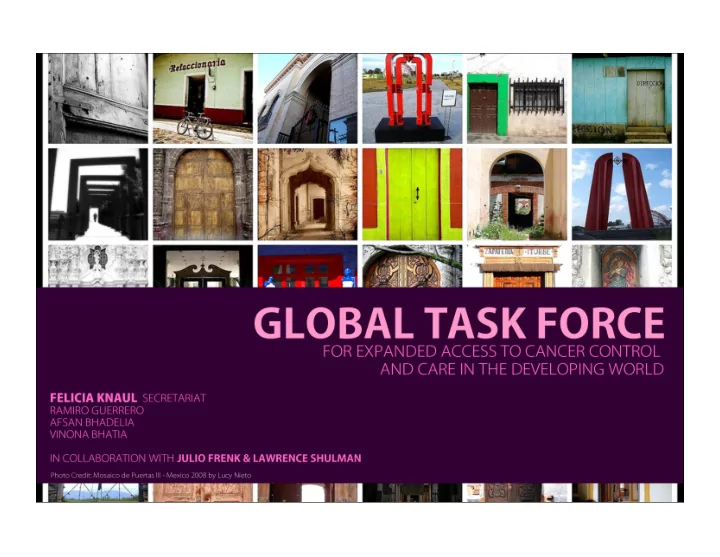

Having a chance to live should not be an accident of geography …nor be defined by income 100 Case Fatality Rate 80 Prostate Cervix 60 Breast Non-Hodgkin Lymphoma 40 Colorectal Hodgkin’s 20 Lymphom Melanoma Thyroid Testis 0 Low income Lower middle Upper middle income High income income POOR RICH
Having a chance to live should not be an accident of geography …nor be defined by income Pancreas 100 Case Fatality Rate 80 60 40 Cervix Breast 20 Prostate Testis Low income Lower middle Upper middle income High income income POOR RICH
We have seen success: 18 Rate per 100,000 women adjusted for age Mortality rates 14 breast and 10 cervical cancer 6 in Mexico 2 1955-2007 0 1955 1965 1975 1985 1995 2005 2007 2006: BC>CC. …for the first time in more than 5 decades. Fuente: Lozano, Knaul, Gómez-Dantés, Arreola-Ornelas y Méndez, 2008, Tendencias en la mortalidad por cáncer de mama en México, 1979-2007. FUNSALUD, Documento de trabajo. Observatorio de la Salud, con base en datos de la OMS y la Secretaría de Salud de México.
Global task force on expanded access to cancer control and care 1. Initiative of HGEI, DFCI, HSPH, HMS 2. ~ 20 leaders from throughout the world, Honorary co-President, Co-chairs, Technical Advisory Group 3. Design and promote innovations in delivery of cancer care and control White Paper - 2010
Global task, local action 1.Global and regional task: creation of global facilities and strategies for the financing, procurement and delivery of affordable, essential cancer drugs 2.Local action: implementation of innovative service delivery models that are adapted to local contexts, and respond to the opportunities and needs of specific health systems
Towards a set of strategies: areas of work – white paper 1. Which cancer is first – by region? 2. What is the basic package of services, and drugs (prevention, early detection, treatment) 3. Reaching potential demand 4. Innovations in financing and procurement 5. Innovations in delivery 6. Monitoring and evaluation
Identify and apply innovations in country- and health system-specific 1. Optimize human and physical resources and harness the primary and secondary levels of care: Task shifting (BCE) Infrastructure shifting (chemo) Mobilize communication technology (remote/teleconsultation for quality and safety) Harvard Global Equity Initiative
Develop and promote regional and global price-procurement negotiation 1.Learn from global and regional successes: AIDs, vaccines and other diseases 2.Collaboration and support from experienced institutions: the Global Fund, UNAIDs, GAVI 3.Involve countries and governments; regional and global institutions (WHO, the World Bank, regional Banks, etc)
Meat and potatoes*: Adjust, apply and appraise 1.Original site – Malawi, Rwanda, Haiti - Partners in Health - DFCI 2.Proposed: Jordan, King Hussein Cancer Foundation; National Institute of Cancer of Mexico 3.We hope that an outcome of this meeting will be the identification of potential collaborating sites and opportunities to share with existing programs. *Lawrence Shulman Harvard Global Equity Initiative
Recommend
More recommend